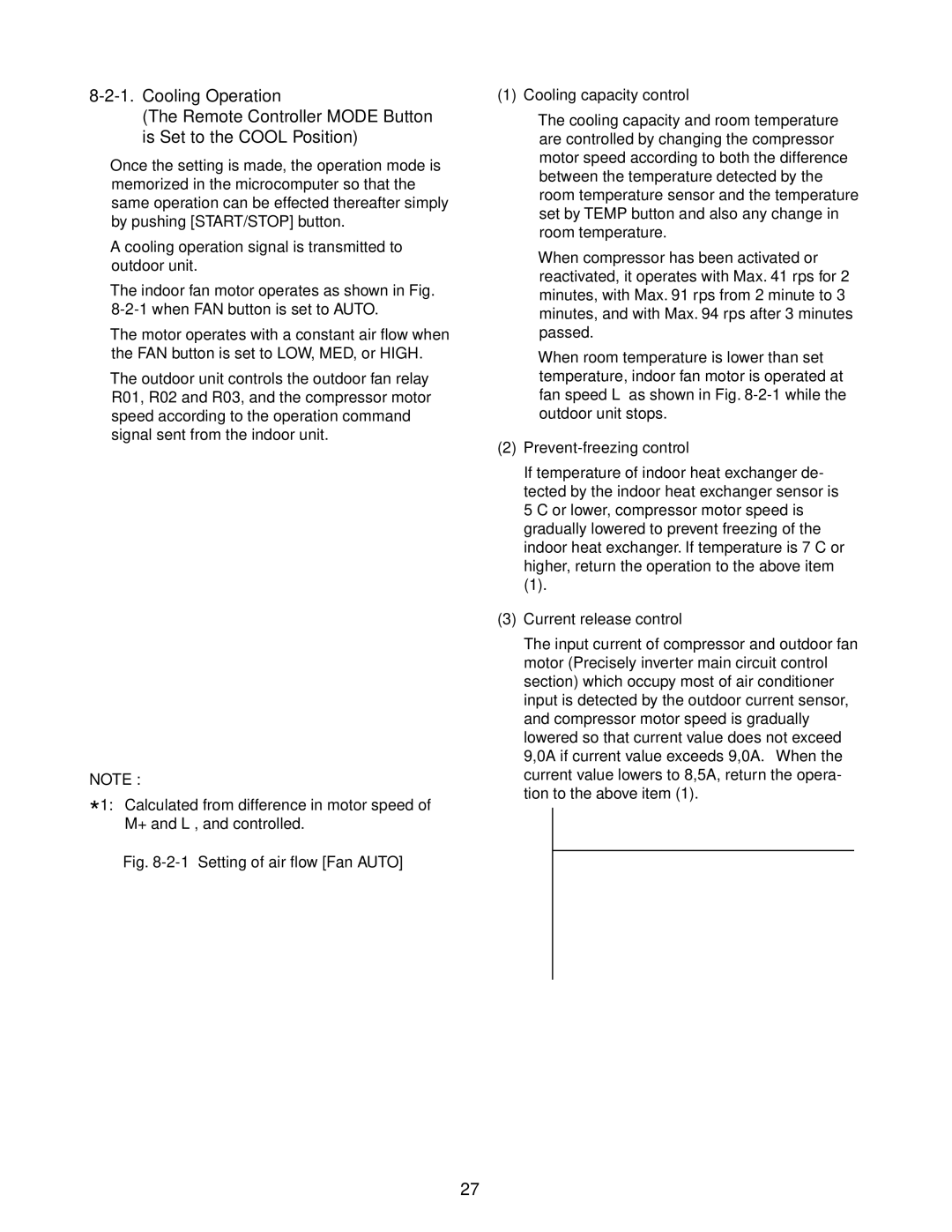
(The Remote Controller MODE Button is Set to the COOL Position)
•Once the setting is made, the operation mode is memorized in the microcomputer so that the same operation can be effected thereafter simply by pushing [START/STOP] button.
•A cooling operation signal is transmitted to outdoor unit.
•The indoor fan motor operates as shown in Fig.
•The motor operates with a constant air flow when the FAN button is set to LOW, MED, or HIGH.
•The outdoor unit controls the outdoor fan relay R01, R02 and R03, and the compressor motor speed according to the operation command signal sent from the indoor unit.
temp.) | ˚C |
|
| ||
|
| ||||
+3 |
|
| |||
|
|
|
| ||
(Set– | +2,5 |
| M+ | ||
*1 | |||||
|
|
|
| ||
temp.) | +2 |
|
| ||
+1,5 | *1 | ||||
|
|
|
| ||
(Room | +1 | *1 | |||
| L– | ||||
|
|
|
| ||
|
| +0,5 |
|
| |
Set |
| 0 |
|
| |
|
| In normal | |||
temp. |
|
|
| ||
|
|
|
| operation | |
|
|
|
|
| |
|
|
|
|
|
|
NOTE :
*1: Calculated from difference in motor speed of M+ and
Fig. 8-2-1 Setting of air flow [Fan AUTO]
(1)Cooling capacity control
•The cooling capacity and room temperature are controlled by changing the compressor motor speed according to both the difference between the temperature detected by the room temperature sensor and the temperature set by TEMP button and also any change in room temperature.
•When compressor has been activated or reactivated, it operates with Max. 41 rps for 2 minutes, with Max. 91 rps from 2 minute to 3 minutes, and with Max. 94 rps after 3 minutes passed.
•When room temperature is lower than set temperature, indoor fan motor is operated at fan speed L– as shown in Fig.
(2)Prevent-freezing control
If temperature of indoor heat exchanger de- tected by the indoor heat exchanger sensor is 5°C or lower, compressor motor speed is gradually lowered to prevent freezing of the indoor heat exchanger. If temperature is 7°C or higher, return the operation to the above item
(1).
(3)Current release control
The input current of compressor and outdoor fan motor (Precisely inverter main circuit control section) which occupy most of air conditioner input is detected by the outdoor current sensor, and compressor motor speed is gradually lowered so that current value does not exceed 9,0A if current value exceeds 9,0A. When the current value lowers to 8,5A, return the opera- tion to the above item (1).
(A) |
| Comp. motor | |
| speed down | ||
value | 9,0 | ||
| |||
|
| ||
Current |
| Comp. motor | |
8,5 | speed keep | ||
| |||
|
| ||
|
| Normal control | |
|
| Fig. |
(4)Outdoor temperature release control
The outdoor temperature release is controlled by changing the current release points 9,0 and 8,5 in the above item according to temperature detected by the outdoor temperature sensor.
For example, if the outdoor temperature is 43°C, the value of current release point becomes 8,0A.
– 27 –
